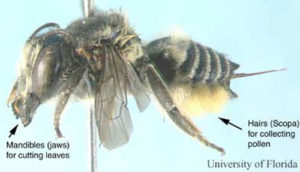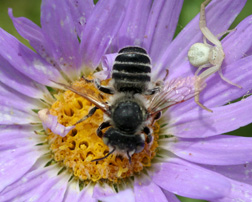Identification
Leafcutter bees are a unique group of bees in both morphology and nesting behaviors. They are included under the family Megachilidae which means “big-lipped”. The name is fitting for these bees because they have a set of large mandibles that are useful for cutting leaves. Female leafcutter bees also have a very hairy underside of their abdomen that they use to carry pollen and is another defining characteristic of these bees.
Leafcutter bees typically nest in rotting wood, soil, and plant stems, but can nest in a variety of different locations. Female bees will cut circles from plant leaves, and sometimes petals, to line their nest cavity. Some plants that are preferable to these insects are roses, azaleas, redbuds, and bougainvillea. The cuttings may damage the overall appearance, but they don’t harm the health of the plant.
Biology
Adult leafcutter bees will usually overwinter in their nests and will chew their way out once spring has arrived. After emergence, a female leafcutter bee will mate and start constructing her new nest. She will use preexisting holes to construct a cigar-shaped cavity that contains several brood cells and line them with leaf cuttings. She will then place a ball of pollen in the back of the cavity, lay an egg, and then close the cell. When the larva emerges as an adult, the bee will chew through the barriers to leave the nest.

Leafcutter bee nest – cigar shaped leaf lining
Leafcutter bees are a non-aggressive species of bee and will only sting if handled. They are also important pollinators of wildflowers, fruits, and vegetables. The alfalfa leafcutter bee (Megachile rotundata) is especially important in pollinating alfalfa plants for commercial production. If you are interested in providing nesting cavities for leafcutter bees, there are several nest structures that are easy to make at home, but are also available to purchase online.


